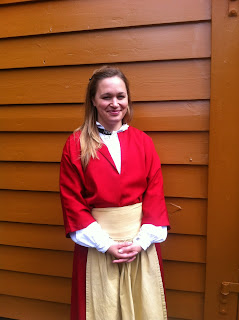July 14th
Gail and I reached Bergen Wednesday night. Our final train ride. The next morning we toured Bryggen, the city's historic district. A guide ferried us through several museums along the harbor. She is an historian who came from Germany, and now teaches at a nearby university. The entire quarter has been restored using medieval techniques. Walking through it all provided a true sensation of how things evolved over time.
Bergen was a fishing center in the 1300s. There were abundant cod and other high value catches. But no export markets had been created. The economy operated below its potential. The Germans swooped into Bergen around that time. The city became one of four primary trading centers in the Hanseatic League. That was a commercial enterprise that operated beyond any state's authority. It had its own regulations and policies. It also maintained its own security forces. The Germans purchased the local fishermen's catch, processed it, and traded it with England, Germany, Russia, and other parts of Europe for grain, clothing, and other products. The League dominated Europe's economy into the 1700s and remained operational until late in the 1800s.
The museums showed how it all worked in great detail. The buildings were carefully restored. Accounting records were displayed. Living quarters held numerous artifacts. Our guide explained how the Germans kept to themselves. Fraternization with the locals was prohibited. Over time some of the Germans married into the Norwegian culture. Today the Bergen population is full of people with German heritage. The local authorities began taxing the Hanseatic League in the 1700s. The military grew strong enough to enforce payment. Ultimately the king took over the business altogether.
Gail and I toured the rest of the city in the afternoon. We were able to re-enter the museums. That gave us a closer look at the artifacts. We also visited the castle which abutted Bryggen. The fortress protected the harbor. It also was used by the nobles in later years to threaten the Germans, ensuring collection of taxes. Downtown Bergen isn't a large place even though it is Norway's second largest city. Much commerce and industry has sprawled into the countryside. Gail and I checked out the fish market, several parks and squares, and quite a few historical buildings. Then we returned to Bryggen for a late lunch.
"Are you from the Tucson Racquet Club?" People go to great lengths to escape the Arizona heat in summer. Ellen, who belongs to the same health club as me, asked me that in front of the Hanseatic Museum. Small world! Ellen and her daughter had just finished climbing up and down the local mountain. Most tourists take the funicular. Being exercise aficionados, they had hiked it. We compared notes and promised to catch up in the fall back in Tucson.




No comments:
Post a Comment